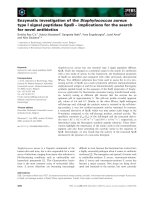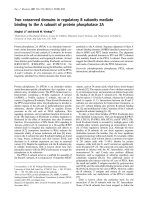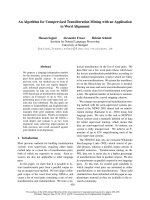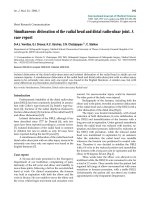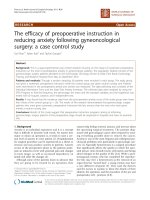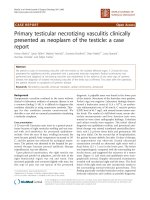Báo cáo khoa học: "Endocarditis caused by methicillin-susceptible Staphylococcus aureus with reduced susceptibility to vancomycin: a case report" pps
Bạn đang xem bản rút gọn của tài liệu. Xem và tải ngay bản đầy đủ của tài liệu tại đây (1 MB, 6 trang )
CAS E REP O R T Open Access
Endocarditis caused by methicillin-susceptible
Staphylococcus aureus with reduced susceptibility
to vancomycin: a case report
Beatriz Perazzi
1*
, Natalia Bello
2
, Marta Mollerach
3
, Carlos Vay
1
, María Beatriz Lasala
2
and Angela Famiglietti
1
Abstract
Introduction: Staphylococcus aureus is the most common cause of acute infective endocarditis.
Recent reports have described heteroresistance to vancomycin associated with methicillin-resistant Staphylococcus
aureus. We present the first case report in Argentina of the failure of treatment with vancomycin in endocarditis
caused by methicillin-susceptible Staphylococcus aureus containing subpopulations with reduced suscep tibility to
vancomycin.
Case presentation: We report the case of a 66-year-old Hispanic man with infective endocarditis complicated by
septic emboli in the lumbosacral spine and the left iliopsoas muscle. This disease was caused by methicillin-
susceptible Staphylococcus aureus containing subpopulations with reduced susceptibility to vancomycin. He was
initially treated with cephalothin and gentamicin but developed a rash caused by beta-lactams and interstitial
nephritis. For that reason, the treatment was subsequently switched to vancomycin but he failed to respond. The
infection resolved after administration of vancom ycin in combination with gentamicin and rifampin.
Conclusion: Our case report provides important evidence for the existence of subpopulations of methicillin-
susceptible Staphylococcus aureus that have reduced susceptibility to vancomycin which would account for
treatment failure. Our case ra ises an alert about the existence of these strains and highlights the need to
determine the vancomycin minimum inhibitory concentration of Staphylococcus aureus to screen for the presence
of strains that have reduced vancomycin susceptibility at different infection sites.
Introduction
Staphylococcus aureus is the most common cause of
acute infective endocarditis (IE). S. aureus has developed
resistance to every beta -lactam antibiotic that has been
introduced into clinical medicine. Recent reports have
described heteroresistance to vancomycin associated
with methicillin-resistant S. aureus (MRSA) [1]. How-
ever, the scope and clinical significance of such isolates
are yet to be completely defined.
We present the first case report in Argentina of the fail-
ure of vancomy cin treatment for endocarditis ca used by
methicillin-susceptible S. aureus (MSSA) containin g sub-
populations with reduced susceptibility to vancomycin.
Case presentation
We report the case of a 66-year-old Hispanic man with
a history of diabetes, psoriasis, smoking, alcoholism,
hospital ization in the previous year due to upper gastro-
intestinal bleeding (UGB), gastric ulcer and bacteremic
lower limb cellulitis caused by MSSA, who received
intravenous cephalothin for 14 days. The patient had
not previously been exposed to glycopep tide antibiotics.
At admission, he pr esent ed with a febrile syndrome and
chills and complained of lumbar pain that had persisted
for more than 20 days. On physical examination, the
patient was mentally alert and had a blood pressure of
110/70 mmHg, a heart rate of 70 beats/minute and a
respiration frequency of 18 beats/minute. A systolic
murmur (grade 4/6) was detected in the aortic and
mitral valves. He also had lower limb hypotrophia with
no pain when flexing, extending or rotating t he hip. A
hematological study showed hematocrit levels of 28%, a
* Correspondence:
1
Clinical Bacteriology Laboratory. Department of Clinical Biochemistry.
Hospital de Clinicas. Faculty of Pharmacy & Biochemistry. University of
Buenos Aires. Córdoba 2351, Capital Federal. City of Buenos Aires. Argentina
Full list of author information is available at the end of the article
Perazzi et al. Journal of Medical Case Reports 2011, 5:292
/>JOURNAL OF MEDICAL
CASE REPORTS
© 2011 Perazzi et al; licensee BioMed Central Ltd. This is an Open Access article distributed under the terms of the Creative Commons
Attribution License ( which permi ts unrestricted use, distribution, and reproduction in
any medium, provid ed the original work i s properly cited.
hemoglobin concentration of 9.6 g/dL, a white blood
cell count of 11,600/mm
3
with 85% polymorphonuclear
leuko cytes, a platelet count of 197,000/mm
3
and an ery-
throcyte sedimentation rate (ESR) of 130 mm in the
first hour.
Blood cultures performed at admittance were positive
for MSSA (SA1) in both samples taken after 18 hours.
The SA1 strain was susceptible to the following non-
beta lactam antibiotics: gentamicin, minocycline, tigecy-
cline, rifampin, cotrimoxazol, vancomycin, teicoplanin,
levofloxacin, ciprofloxacin and linezolid. The vancomy-
cin MIC determined by the broth microdi lution method
was 1 μg/mL. Nuclear MRI of the spine showed spondy-
lodiscitis at the L5-S1 level with left iliopsoas muscle
involvement.
The transesophageal echocardiogram (TEE) performed
48 hours after admission showed a mass compatible
with vegetation and an anterior mitral valve leaflet
abscess c ausing mild mitral failure (Figure 1): this was
interpreted as IE with septic emboli involving the lum-
bosacral spine and the left iliopsoas muscle. Intravenous
antibiotic treatment wit h cephalothin (2 g/6 hours) and
gentamicin (240 mg/day) was started. Subseq uent echo-
cardiograms performed 15 days after the start of the
treatment did not reveal any abscesses or changes in
vegetation size. A blood culture performed as a control
10 days after the start of the treatment was negative.
On day 26 of cephalothin administration, our patient
developed a rash caused by beta-lactams with eosinophi-
lia and urinary sediment findings that w ere compatible
with interstitial nephritis. For that reason, treatment was
switched to intravenous vancomycin (1 g/12 hours) until
day 42, when a new TEE was performed, which showed
no vegetation. H e was discharged due to improvement
of his condition. However, a week later, a new blood
culture was positive for MSSA (SA2) in both samples
after 19.5 hours, showing the same antibiotic suscept-
ibility and a vancomycin MIC of 1 μg/mL. He was read-
mitted 48 hours after the blood culture was performed.
Immediate treatment was started with intravenous van-
comycin (1 g/12 hours), gentamicin (240 mg/day) and
rifampin (300 mg/6 hours).
A TEE performed 48 hours after hospitalization
revealed a mass compa tible with recently established
aortic valve vegetation producing mild valv ular failure.
A mass attached to the anterior mitral valve leaflet was
also observed, which suggested the presence of pre-
viously attached vegetation causing mild mitral failure.
Our patient remained hemodynamically stable, afebrile
and his physical examination was unremarkable. The
treatment was monitored by a time-kill curve and by
vancomycin dosage. The serum bactericidal rate showed
bactericidal effects after 24 hours. The trough serum
vancomycin concentration was 14.1 mg/L. Gentamicin
was discontinued after 21 days due to renal failure. A
TEE performed 20 days after hospitalization showed
remission of the mass. A tomography-guide d needle
puncture of the lesion in the left iliopsoas muscle
showed no microbiological growth.
Our patient completed intravenous treatment with
vancomycin (42 days), gentamicin (21 days) and rifam-
pin ( 36 days). Because the blood culture was negative,
he was discharged.
Polyme rase chain reaction detection of the mecA gene
was negative in both isolates.
The v ancomycin MIC for SA1 and SA2 with the st an-
dard inoculum (10
5
)was0.5and1μg/mL, respectively,
and the minimum bactericidal concentration (MBC) was
0.5 and 128 μg/mL, respectively. A higher inoculum
(10
7
) increased the MIC to 2 μg/mL and the MBC to
512 μg/mL in bo th isolates. After stimulation with
increasing subinhibitory concentrations of vancomycin
(SA3), the MIC and MBC with the standard inoculum
were the same, whereas at a higher inoculum (10
7
), the
values increased to 4 μg/mL and 512 μg/mL for the
MIC and MBC, respectively.
In the populat ion analysis of SA2 and SA3, a develop-
ment of colonies up to 3 and 4 μg/mL, re spectively, was
observed, with growth between 1 and 4 μg/mL, which
was 2 to 4 logs more than in SA1, which developed up
to 2 μg/mL (Figure 2). SA2 and SA3 were identified as
heterogeneous vancomycin-intermediate S. aureus
(hVISA) on the basis of t he population analysis profil-
ing-area under the curve (PAP-AUC) ratios, showing
PAP-AUC ratios of 1 .06 and 1.26, respectively, com-
pared to the AUC of the Mu3 strain, whereas SA1 was
identified as vancomycin-susceptible, showing a PAP-
Figure 1 Transesophageal echocardiogram.Aroundedmass,1
cm in diameter, attached to the auricular side of the anterior mitral
valve leaflet, compatible with vegetation and abscess, is observed. A
smaller mass, 0.5 cm in diameter, is observed on top of the
abovementioned mass, causing mild mitral failure.
Perazzi et al. Journal of Medical Case Reports 2011, 5:292
/>Page 2 of 6
AUC ratio of 0.83, compared to the AUC of the Mu3
strain [2].
Electron microscopy of SA2 showed a thickened cell
wall (Figure 3).
The clonal relationship determined by pulsed-field gel
electrophoresis showed that both S. aureus isolates dis-
played indistinguishable electrophoretic patterns.
Discussion
IE is a disease in which the endocardial surface of the
heart is invaded by infectious microorganisms. S. aureus,
which is a common cause of acute IE, is difficult to treat
and establishes an aggravated infection if the therapeutic
options are limited because of adverse effects or reduced
susceptibility to antibiotics.
0
1
2
3
4
5
6
7
8
9
10
012 3456 7816
S. aureus ATCC 29213
Mu50
Mu3
SA1
SA2
SA3
0.5 1.5
Vancom
y
cin concentration
(
μ
g
/ml
)
Log
10
C
FU
/
ml
Figure 2 Population analysis of isolates SA1, SA2, SA 3, S. aureus ATCC 29213 (VSSA), S. aureus Mu3 (hVISA) and S. aureus Mu50
(VISA), assessed by susceptibility to vancomycin.
Figure 3 Electron microscopy of the cell wall. A. SA2, Cell wall thickness: 23.5 nanometers. B. Cell wall thickness of S. aureus ATCC 29213
strain: 15.6 nanometers.
Perazzi et al. Journal of Medical Case Reports 2011, 5:292
/>Page 3 of 6
IE due to S. aureus has a slow microbiological resolu-
tion when treated with vancomycin. This persistent bac-
teremia could be due to the presence of a metas tatic
infectious focus, such as that in the left iliopsoas muscle
and the vertebrae. Because vancomycin has poor bone
pen etration, the initial monotherapy with this antibiotic
combined with short-duration parenteral antimicrob ial
treatment may have failed to sterilize the bone. Negative
cultures resulting from the aspiration biopsy of the mus-
cle lesion cannot rule out the presence of a metastatic
infectious focus, because this procedure has very low
diagnostic sensitivity, especially in patients pre-treated
with anti biotics. Another possible explanation of persis-
tent bacteremia is that in this case, the isolate showed a
vancomycin MIC ≥ 1 μg/mL, which could justify treat-
ment failure and control of the infection with the com-
bined treatment. In this respect, it i s worth mentioning
that treatment of MSSA bacteremia with vancomycin is
not optimal, as has been clearly demonstrated in several
studies. The slow bactericidal activity of this antibiotic is
responsible for its high probability of therapeutic failure,
which increases as the MIC increases, even within t he
susceptibility range [3]. There are several strategies to
deal with this situation. The use of high doses of vanco-
mycin (15-20 mg/kg/8 to 12 hours) in complicated
infections to obtain troug h serum concentrations of 15-
20 mg/L and an AUC/MIC of > 400 has elicited a better
therapeutic response in strains with MICs ≤ 1 μg/mL,
despite higher rates of nephrotoxicity, which requires
serum concentration monitoring of the drug [4]. The
combination of vancomycin with other antibiotics, as in
our case, is another possible strategy. Rifampin is a first-
line anti-staphylococcal agent. However, some studies
sugg est that its combination with vanco mycin may have
ant agonistic effects, although this was not the c ase with
our patient [5]. Rifampin could have been effective here
due to the patient’s bone involvement in the spine. The
combination of vancomycin with gentamicin was a pre-
vious recommendation of the Infectious Diseases Society
of A merica and the American Heart Association to has-
ten clearance of blood cultures; this has recently been
changed due to findings of enhanced nephrotoxicity
with no real morbidity and/or mortality benefit [6].
An MIC of 1 μg /mL is not very frequent in S. aureus
isolates. However, isolates with intermediate vancomycin
susceptibility with MICs of 4-8 μg/mL (vancomycin-
intermediate S. aureus: VISA, or glycopeptide-intermedi-
ate S. aureus: GISA) have been reported since 1997
[1,7-9]. Isolates which appear to be vancomycin-suscep-
tible (MIC ≤ 2 μg/ml) but contain subpopulations
expressing reduced susceptibility, known as heteroresis-
tance (hVISA, or heterogeneous glycopeptide-interme di-
ate S. aureus: hGISA), have been described [1,10-13].
These strains may exhibit vancomycin MICs of 1-2 μ g/
mL. Although the PAP-AUC method is considered the
gold standard method for detection of hVISA strains, it
is actually t oo time-consumi ng and labor- intensive for a
clinical laboratory. Therefore, a new Etest hGISA/GISA
resistance detection (GRD) strip (E-vancomycin/teico-
planin+supplement) recently validated in the US, has
been described by Yusof et al. for detection of vancomy-
cin heteroresistance [14]. The best performance for
hGISA d etection was found with the GRD strip on
Mueller-Hinton blood with a sensitivity of 94% and a
specificity of 95% at 48 hours, considering cutoff values
of ≥ 8 for teic oplanin or vancomy cin. The authors con -
sideredthattheresultsforthe GRD strip reading after
18 to 24 hours of incubation, if positive for hGISA/
GISA, can be reported as such, although negative results
should be confirmed after 48 hours of incubation
because the sensitivity was highest at 48 hours [14].
This method has limited availability in Argentina.
The clinical impact of vancomy cin treatment on these
isolates is controversial. Musta et al. [15] compared the
vancomycin MIC by Etest and the frequency of hVISA
for all MRSA blood isolates and correlated the results
with the clinical outcome, detecting hVISA in 30% and
80% of isolates with a vancomycin MIC of 2 and 3 μg/
mL, respectively. An MIC of ≥ 2 g/ml was associated
with a higher mortality rate. However, the vancomycin
MIC a nd hVISA status did not af fect mortality or per-
sistent bacteremia. Bae et al. [16] characterized patients
with IE using a multinatio nal collection of isolates from
MRSA with and without hVISA; they reported that
patients with hVISA had a higher rate of persistent bac-
teremia and congestive heart failure but presented no
differences in mortality from patients who were not
infected with hVISA. hVISA isolates were genotypically
similar to non-hVISA isolates. Maor et al. [17] com-
pared patients who had hVISA bacterem ia with tho se
who had MRSA bacteremia. They reported that hVISA
bacteremia was significantly associated with prolonged
bacter emia duration, greater rates of complications such
as endocarditis and osteomyelitis and emergence of
rifampin resistance, c ompared with MR SA bacteremia.
There was no significant difference in mortality between
patients with hVISA bacteremia and those with MRSA
bacteremia. Several authors have reported treatment fail-
ure with vancomycin in hVISA infections [9]. Moore et
al. [18] described treatment failure with vancomycin in a
patient with hVISA-associated endocarditis, as in our
case. The isolate corresponded to a strain of MRSA,
whereas in our case it was MSSA. In fact, u nlike the
organism observed in our case, most of the isolates
described in the hVISA literature are MRSA. Neverthe-
less, Bo bin-Dubreux et al. [19] in France reported a case
of conjunctivitis due to MSSA in an hVISA isolate, and
Fusco et al. [20] in the US also reported clinical failure
Perazzi et al. Journal of Medical Case Reports 2011, 5:292
/>Page 4 of 6
of vancomycin in a dialysis patient with recurrent
methicillin-susceptible vancomycin-heteroresistant S.
aureus bacteremi a. In addition, Pillai et al. [21] reported
the development of reduced vancomycin susceptibility
in a series of clinical methicillin-susceptible S. aureus
isolates recovered from the b lood and bone of a patient
who experienced vancomycin therapy failure.
Different lines of evidence, such as population analysis
and electron microscopy, suggest th at vancomycin treat-
ment failure of our endocardit is case could have
occurred as a result of an hVISA infection. The fact that
both S. aureus isolates had a clonal relationship suggests
relapse and not reinfection. Considering that the vanco-
mycin doses administered in our case did not reach the
recommended trough serum levels of 15-20 mg/L (14.1
mg/L), it could be assumed that S. aureus subpopula-
tions w ith reduced susceptibility to vancomycin might
have arisen during therapy, thus cont ributing to treat-
ment failure. The infection finally resolved after vanco-
mycin treatment, likely because of its combination with
gentamicin and rifampin.
Treatment failure o f S. aureus endocarditis with o ther
therapeutic alternatives, such as linezolid and daptomy-
cin, have been reported [22,23]. Although clinical
experience with daptomycin in S. aureus endocarditis is
growing [24], the role of this antibiotic in the treatment
of left-sided staphylococcal endocarditis is not clearl y
defined, and its availability in Argentina is limited.
Conclusions
We describe the first case in Argentina of failure of van-
comycin treatment in an acute infe ction caused by an
hVISA methicillin-susceptible strain of S. aureus.Our
report provides important evidence for the existence of
subpopulations of S. aureus with reduced vancomycin
suscepti bility which would account for treatmen t failure
in this case.
This ca se raises an alert about the existence of these
strains, whi ch despite showing vancomy cin MIC values
of ≤ 2 μg/mL, are considered susceptible by the Clinical
and Laboratory Standards Institute (CLSI) [2]. These
strains usually show vancomycin MIC v alues between 1
and 2 μg/mL which could account for treatment failure
in severe infections if the trough serum concentrations
of this antibiotic are lower than 20 μg/mL. Therefore,
the correct management of severe S. aureus infections
with vancomycin requires careful monitoring by deter-
mining the vancomycin MIC and its trough serum con-
centrations in order to adjust the treatment.
These findings raise awareness of the need to have an
adequate screening method for the detection of vanco-
mycin-heteroresistant strains that could be adapted to
clinical laboratories in Argentina.
Consent
Written informed consent was obtained from the patient
for publication of this case report and accompanying
images. A copy of the written consent is available for
review by the Editor-in-Chief of this journal.
Author details
1
Clinical Bacteriology Laboratory. Department of Clinical Biochemistry.
Hospital de Clinicas. Faculty of Pharmacy & Biochemistry. University of
Buenos Aires. Córdoba 2351, Capital Federal. City of Buenos Aires. Argentina.
2
Division of Infectious Diseases. Hospital de Clinicas. Faculty of Medicine.
University of Buenos Aires. Córdoba 2351, Capital Federal. City of Buenos
Aires. Argentina.
3
Microbiological Laboratory. Department of Microbiology,
Immunology and Biotechnology. Faculty of Pharmacy & Biochemistry.
University of Buenos Aires. Junín 956, Capital Federal. City of Buenos Aires.
Argentina.
Authors’ contributions
NB and MBL performed clinical work, BP, MM, CV and AF carried out
laboratory work, and all contributed to writing the article. All have read and
approved the final manuscript.
Competing interests
The authors declare that they have no competing interests.
Received: 29 March 2010 Accepted: 7 July 2011 Published: 7 July 2011
References
1. Hiramatsu K, Aritaka N, Hanaki H, Kawasaki S, Hosoda Y, Hori S, Fukuchi Y,
Kobayashi I: Dissemination in Japanese hospitals of strains of
Staphylococcus aureus heterogeneously resistant to vancomycin. Lancet
1997, 350:1670-1673.
2. Wootton M, Howe RA, Hillman R, Walsh TR, Bennett PM, MacGowan AP: A
modified population analysis profile (PAP) method to detect hetero-
resistance to vancomycin in Staphylococcus aureus in a UK hospital. J
Antimicrob Chemother 2001, 47:399-403.
3. Chang FY, Peacock J, Musher M, Triplett P, MacDonald B, Mylotte JM,
O’Donnell A, Wagener MM, Yu VL: Staphylococcus aureus bacteremia:
Recurrence and the impact of antibiotic treatment in a prospective
multicenter study. Medicine 2003, 82:333-339.
4. Rybak MJ, Lomaestro BM, Rotschefer JC, Moellering RC, Craig WA, Billeter M,
Dalovisio JR, Levine DP: Vancomycin therapeutic guidelines A summary
of consensus recommendations from the Infectious Diseases Society of
America, the American Society of Health-System Pharmacists and the
Society of Infectious Diseases Pharmacists. Clin Infect Dis 2009, 49:325-327.
5. Levine DP, Fromm BS, Reddy BR: Slow response to vancomycin or
vancomycin plus rifampin in methicillin-resistant Staphylococcus aureus
endocarditis. Ann Intern Med 1991, 115:739-741.
6. Cosgrove SA, Vigliani GA, Campion M, Abrutyn E, Corey GR, Levine DP,
Rupp ME, Chambers HF, Karchmer AW, Boucher HW: Initial low-dose
gentamicin for Staphylococcus aureus and endocarditis is nephrotoxic.
Clin Infect Dis 2009, 48:713-721.
7. Fridkin SK, Hageman J, McDougal LK, Mohammed J, Jarvis WR, Perl TM,
Tenover FC: Epidemiological and microbiological characterisation of
infections caused by Staphylococcus aureus with reduced susceptibility
to vancomycin, United States, 1997-2001. Clin Infect Dis 2003, 36:429-439.
8. Hiramatsu K, Hanaki H, Ino T, Yabuta K, Oguri T, Tenover FC: Methicillin-
resistant Staphylococcus aureus clinical strain with reduced vancomycin
susceptibility. J Antimicrob Chemother 1997, 40:135-136.
9. Ploy MC, Grelaud C, Martin C, de Lumley L, Denis F: First clinical isolate of
vancomycin-intermediate Staphylococcus aureus in a French hospital.
Lancet 1998, 351:1212.
10. Ariza J, Pujol M, Cabo J, Pena C, Fernandez N, Linares J, Avats J, Gudiol F:
Vancomycin in surgical infections due to methicillin-resistant
Staphylococcus aureus with heterogeneous resistance to vancomycin.
Lancet 1999, 353:1587-1588.
11. Geisel R, Schmitz FJ, Thomas L, Berns G, Zetsche O, Ulrich B, Fluit AC,
Labischinsky H, White W: Emergence of heterogeneous intermediate
Perazzi et al. Journal of Medical Case Reports 2011, 5:292
/>Page 5 of 6
vancomycin resistance in Staphylococcus aureus isolates in the
Dusseldorf area. J Antimicrob Chemother 1999, 43:846-848.
12. Reverdy ME, Jarraud S, Bobin-Dubreux S, Burel E, Girardo P, Lina G,
Vandenesch F, Etienne J: Incidence of Staphylococcus aureus with
reduced susceptibility to glycopeptides in two French hospitals. Clin
Microbiol Infect 2001, 7:267-272.
13. Trakulsomboon S, Danchaivijitr S, Rongrungruang Y, Dhiraputra C,
Susaemgrat W, Ito T, Hiramatsu K: First report of methicillin resistant
Staphylococcus aureus with reduced susceptibility to vancomycin in
Thailand. J Clin Microbiol 2001, 39:591-595.
14. Yusof A, Engelhardt A, Karlsson A, Bylund L, Vidh P, Mills K, Wootton M,
Walsh TR: Evaluation of a new Etest vancomycin-teicoplanin strip for
detection of glycopeptide-intermediate Staphylococcus aureus (GISA), in
particular, heterogeneous GISA. J Clin Microbiol 2008, 46:3042-3047.
15. Musta AC, Riederer K, Shemes S, Chase P, Jose J, Johnson LB, Khatib R:
Vancomycin MIC plus heteroresistance and outcome methicillin-resistant
Staphylococcus aureus bacteremia: trends over 11 years. J Clin Microbiol
2009, 47:1640-1644.
16. Bae I-J, Federspiel JJ, Miró JM, Woods CW, Park L, Rybak MJ, Rude TH,
Bradley S, Bukovski S, García de la María C, Kanj SS, Korman TM, Marco F,
Murdoch DR, Plesiat P, Rodriguez-Creixems M, Reinbott P, Steed L,
Tattevin P, Tripodi M-F, Newton KL, Corey R, Foeler VG Jr, for the
International Collaboration on endocarditis-microbiology investigator:
Heterogeneous vancomycin-intermediate susceptibility phenotype in
bloodstream methicillin-resistant Staphylococcus aureus isolates from an
international cohort of patients with infective endocarditis: prevalence,
genotype, and clinical significance. J Infect Dis 2009, 200:1355-1366.
17. Maor Y, Hagin M, Belausov N, Keller N, Ben-David D, Rahav G: Clinical
features of heteroresistant vancomycin-intermediate Staphylococcus
aureus bacteremia versus those of methicillin-resistant S. aureus
bacteremia. J Infect Dis 2009, 199:619-624.
18. Moore MR, Perdreau-Remington F, Chambers HF: Vancomycin treatment
failure associated with heterogeneous vancomycin-intermediate
Staphylocococcus aureus in a patient with endocarditis and in the rabbit
model of endocarditis. Antimicrob Agents Chemother 2003, 47:1262-1266.
19. Bobin-Dubreux S, Reverdy ME, Nervi C, Rougier M, Bolmström A,
Vandenesch F, Etienne J: Clinical isolate of vancomycin-
heterointermediate Staphylococcus aureus susceptible to methicillin and
in vitro selection of a vancomycin-resistant derivative. Antimicrob Agents
Chemother 2001, 45:349-352.
20. Fusco DN, Alexander EL, Weisenberg SA, Mediavilla JR, Kreisswirth BN,
Schuetz AN, Jenkins SG, Rhee KY: Clinical failure of vancomycin in a
dialysis patient with methicillin-susceptible vancomycin-heteroresistant
S. aureus. Diagn Microbiol Infect Dis 2009, 65:180-183.
21. Pillai SK, Wennersten C, Venkataraman L, Eliopoulos GM, Karchmer AW:
Development of reduced vancomycin susceptibility in methicillin-
susceptible Staphylococcus aureus. Clin Infect Dis 2009, 49:1169-1174.
22. Ruiz ME, Guerrero IC, Tuazon CU: Endocarditis caused by methicillin-
resistant Staphylococcus aureus: treatment failure with linezolid. Clin
Infect Dis 2002, 35:1018-1020.
23. Murthy MH, Olson ME, Wickert RW, Fey PD, Jalali Z: Daptomycin non-
susceptible methicillin-resistant Staphylococcus aureus USA 300 isolate. J
Med Microbiol 2008, 57:1036-1038.
24. Levine DP: Clinical experience with daptomycin bateremia and
endocarditis. J Antimicrob Chemother 2008, 62(suppl3):35-39.
doi:10.1186/1752-1947-5-292
Cite this article as: Perazzi et al.: Endocarditis caused by methicillin-
susceptible Staphylococcus aureus with reduced susceptibility to
vancomycin: a case report. Journal of Medical Case Reports 2011 5:292.
Submit your next manuscript to BioMed Central
and take full advantage of:
• Convenient online submission
• Thorough peer review
• No space constraints or color figure charges
• Immediate publication on acceptance
• Inclusion in PubMed, CAS, Scopus and Google Scholar
• Research which is freely available for redistribution
Submit your manuscript at
www.biomedcentral.com/submit
Perazzi et al. Journal of Medical Case Reports 2011, 5:292
/>Page 6 of 6
